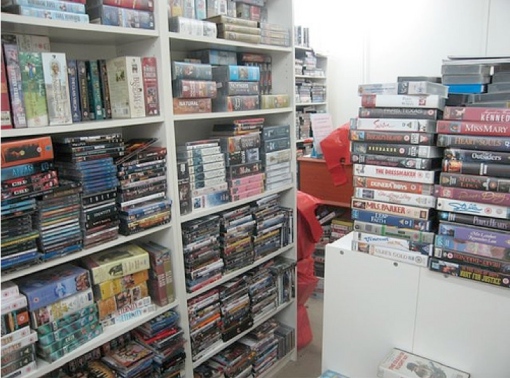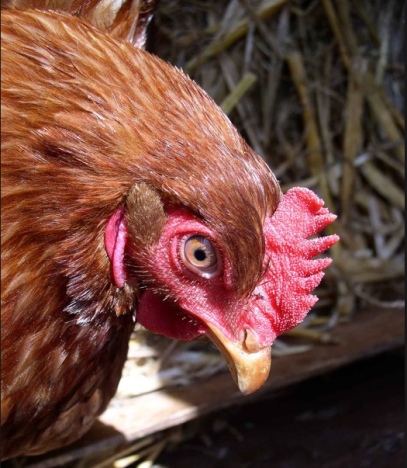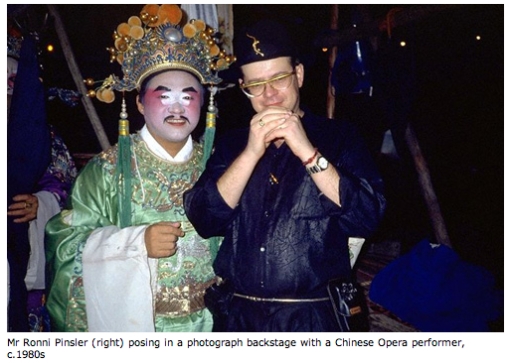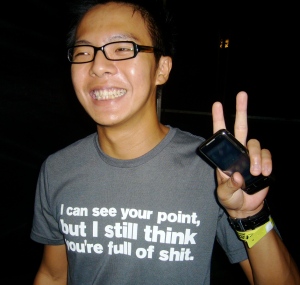I stumbled upon this article written by Ben Slater, Singapore based writer, cineaste and and lecturer at the School of Art, Media and Design at Nanyang Techological University and have taken the liberty of reprinting, I mean uploading it.
Ben pays tribute to Albert Odell known to most as a video store legend in Singapore who passed away almost ten years ago. In this desert of unthinking, unremarkably polite customer service and loyalty programmes, Mr Odell (to his close friends) was an oasis of curmudgeonly, recalcitrant retailing. None of your Starbuckian fake authenticity here. D & O Film and Videos Pte Ltd was as real as a second hand bookshop – another almost extinct retail species in Singapore.
Mr Odell did not rent his videos to just anyone. Many optimistic potential clients were shown the door as soon as they had crossed the ding dong threshold, never to borrow a tape. Others who somehow managed to pass muster and were deemed suitable to give him cash, were invariably subjected to a solid tongue-lashing if they were a day late returning his precious films or, even worse, failed to rewind them.
A colleague recalls being called out of a pitch for a major client by his secretary who insisted there was a most urgent call to take. It was a ferocious barrage from Mr Odell that lasted almost as long as the bombing of Desden.
Being able to say you were a customer was strangely gratifying – the AO Seal of Approval. And if you were on his good side it was a pleasure dropping into his shop and picking his encyclopedic film brain even if his elegantly cheong-sammed wife followed you around the shelves around smiling but thinking “shoplifter”.
I wish I had a photo of Mr Odell to include here but he was fortunately pre-Facebook and a search of Google Images revealed none. I’m glad in a way – social media would have been something else he would have railed against. Along with video downloads of course.
But enough raving. Here is Ben Slater’s eloquent tribute…

The news that Albert Odell, the notoriously cantankerous owner-manager of D & O Film & Videos at Tanglin Shopping Centre had died, seemed to immediately and poignantly epitomise the end of not just an era, but a way of life. At the finale of Once Upon A Time In The West, when Charles Bronson’s character is about to do battle with Henry Fonda, he tells the ageing gunfighter that he’s “the last of an ancient race”. Odell was very much the last of an ancient race. A gwailo born in Hong Kong, fluent in Cantonese and movies, the film business passed down from his father and then his own work with Cathay and Shaw in Singapore. He must have witnessed first-hand in heart-breaking close-up as the film industry here rose and then fell away into nothing.
He was a shop-owner known throughout Singapore, a personality bursting from behind the counter, someone who cared fiercely about his store and its contents. D & O was a one-off—it couldn’t be franchised, branded, marketed, upgraded or diversified. People talked about it and the word spread, and then when you finally entered, you might have had the distinct sense that you weren’t wanted or even needed. This place was open to the public by accident. It was a shrine, a personal collection. To walk through the doors was to take a risk, like slipping through an unlocked front door on a whim.
In the age of hard sell, Odell appeared to have dropped in from another time and place. This wasn’t bad or lazy service (the old Singapore retail curse), rather it was a kind of customer care that was so eccentric to people here as to be offensive. Odell cared far more about the films he rented, than the people they went out to. Like some mythical protector of artifacts, his mission in life was to ensure that the VHS tapes only went to the people who deserved them – those who had proved themselves worthy of the task. So the ex-pats got their Inspectors Morse and Dalgleish no questions asked. Mild murder mysteries to sedate condo insomnia. But for many people, looking up at Odell’s racks of hardcore cinema history, grooving wildly off names like Godard, Fassbinder, Kurosawa, Truffaut, Wenders, Tarkovsky, Altman, Coppola, Bogdanovich, Scorsese, Hitchcock, Roeg, Ray, Hawks, Corman, Suzuki, Beat Takeshi and Wong Kar-Wai (before their were DVDs in libraries, before Amazon.com, before anything) was like seeing the greatest and most magical of treasures that Singapore had never before been able to offer. All the dreams in the dark you had read about in the books. And Odell was the gatekeeper that stood in your way.
My friend Paul was scared of Odell. I was visiting Singapore to make a theatre performance, and we needed two films as research and source material – Powell and Pressburger’s nuns-go- mad-in the Himalayas classic Black Narcissus and the ‘rumble in the jungle’ documentary When We Were Kings. D & O was the only place we would find them in Singapore. Paul insisted I go with him to the shop, just to experience what this guy was like. Odell was gruff, knew Paul by sight, patronised him about rewinding tapes and returning them on time, barely acknowledged me and seemed to be glad to get us out of there as soon as possible. A few days later Paul was on his mobile apologising profusely and desperately about the tapes being late.
Odell brought out this fear, reducing grown adults to the state of quivering, obedient children. At a tribute to him, tales were told that were far worse and more distressing. The man was a tyrant. He put people through hell. Then, little by little he softened, he gave way, he recognised the cinephile in his victims, the passion for films and he got to know those whom he had tormented. We shouldn’t get too sentimental about Odell, like some patriarch in a bad moviewho goes all gooey and sweet in the final reel. I’m sure he wouldn’t want to be remembered like that.
His harsh, uncompromising exterior may have been partly attributed to the battles he fought. A relentless struggle against the petty and ridiculous enforcement of censorship which continually gnawed away at his collection, depriving us of so much in the name of a confused and idiotic set of moral judgments. It was obvious to those who listened to his absurd tales of ‘conversations with the censor’, that this pained him a great deal. Then he struggled for standards – for the basic politeness of returning tapes on time (and properly rewound) that meant so much to him. Small acts of selflessness which he could at least enforce in his tiny corner of the island.
Most of all he struggled for great cinema. Without saying it, he seemed to understand that good films are something truly worth suffering for, and because of that he should not be forgotten.
For more of Ben’s writing go to http://www.gonetopersia.com/downloads/dotc1.pdf
 And a round of applause Ray Poynter and Sue York of The Future Place who do this for virtually nothing except the warm glow of helping the research community.
And a round of applause Ray Poynter and Sue York of The Future Place who do this for virtually nothing except the warm glow of helping the research community.








